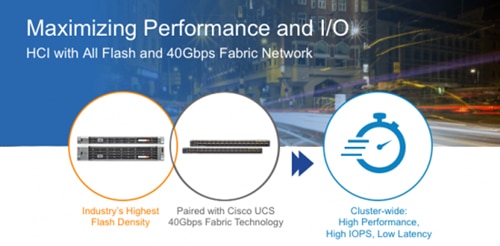
Cisco has released the latest version of its hyperconverged system, HyperFlex 2.0. This new update is all about maximizing performance of applications in the data center. Cisco is also announcing two new, all-flash nodes for HyperFlex, the HyperFlex 220c All Flash and HyperFlex 240c all flash nodes.
HyperFlex is the combination of Cisco UCS and the Cisco HyperFlex HX Data Platform. HyperFlex is designed to bring simplicity while increasing operational efficiency and adaptability. Version 2.0 adds in new innovations in compute, storage, and networking. Along with the new all-flash nodes, Cisco is also supporting higher throughput via 40Gb/s 3rd generation UCS fabric networking.
HyerFlex offers several configuration options including compute-only nodes. Customers can mix and match nodes to meet their specific performance needs. Now users can mix in the new all-flash nodes as well as the hybrid HX nodes. This, combined with the 40Gb/s fabric networking, will give customers even more of a performance boost in the mission critical workloads.
HyperFlex 220C and 240c key specifications:
- HX 220c
- Memory: Up to 1.5TB
- CPU: 2 x Intel Xeon processor E5-2600 v4 family
- PCIe 3.0 slots: 2
- Capacity: up to 6 x 3.8TB drives
- Cisco UCS Virtual Interface Card (VIC) 1227
- VMware vSphere ESXi 6.0 software preinstalled
- HX 240c
- Memory: Up to 1.5TB
- CPU: 2 x Intel Xeon processor E5-2600 v4 or v3 family
- PCIe 3.0 slots: 6
- Capacity: up to 38TB
- Cisco UCS Virtual Interface Card (VIC) 1227
- VMware vSphere ESXi 6.0 software preinstalled
Beyond the new flash nodes and 40Gb/s networking support, Cisco hasn’t done much to help the industry understand where HyperFlex fits into the very crowded HCI space. In thier blog post announcing 2.0, Cisco makes claims that they’re “rapidly expand across a broader set of new customers and verticals” and “customers can expect blazing fast performance with up to 6X IOPS throughput and 80% reduction in latency.” Unfortunately it’s hard to know what any of that means without context, and with vSAN continuing to be the clear leader in HCI adoption with over 7,000 customers, it’s hard to fully suss out Cisco’s plan. Further adding to the confusion in vision is the acquisition of a key Cisco HCI partner in Simplivity, by HPE. Hopefully Cisco clarifies the message this year and shows us why HyperFlex should be taken as a serious player in the hyperconverged market. Otherwise, HyperFlex could go the way of Whiptail, the all flash array that Cisco bought for $415 million then killed in under two years.
Sign up for the StorageReview newsletter

